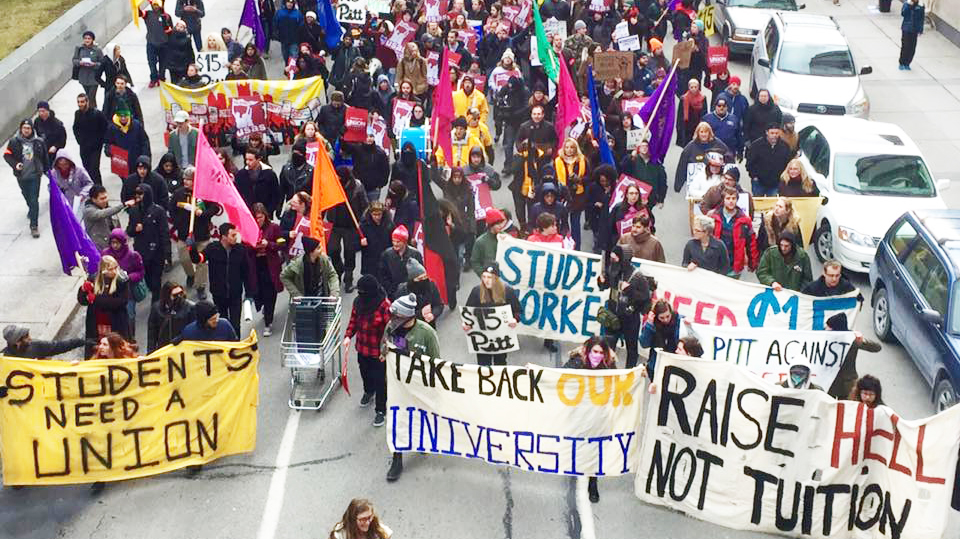
Karl Marx once observed, “The younger generation is in step with me.” In 1905, Lenin wrote, “All we have to do is to recruit young people more widely and boldly … without fearing them. … The youth – the students, and still more so the young workers – will decide the issue of the whole struggle.”
Why do Communists attach special importance to the role of young people? What is the purpose of the Young Communist League, and what should inform its approach?
Youth as a special question
Young people face unique problems under capitalism. These problems are generally felt most sharply by working-class youth, but also cut across class lines and affect other segments of the young generation.
African Americans, Latinos, Asian Americans, immigrants, women and LGTBQ people also experience unique class and extra-class forms of oppression.
Marxism refers to these kinds of cross-class issues as “special questions.”
In The Urgency of NOW: African Americans and Women Dee Miles deals with special questions as they relate to Black people and women. Miles expounds on the exploitation common to all workers, the commonalities that exist within specially oppressed groups as a whole, pointing to the super-exploitation of workers within these oppressed groups, and its implication for developing unity in the struggle for advanced democracy and socialism. She writes, “A special question stands alongside the class question and means in addition to the exploitation experienced by ALL workers, African American and women workers also experience other forms of oppression with members of their group who are not of the working class.”
A similar approach applies to the unique problems of young people, which also overlap with those of other specially oppressed groups.
Police, for example, frequently wage violence on young people’s bodies and lives, particularly on those of African Americans and Latinos. In this regard, LGBTQ youth and trans youth of color have also been targeted.
The environmental crisis threatens today’s young people with a traumatic and early end not only to their own lives, but also to human existence itself. Health care is another area where youth face special problems as they transition from living with parents where they’re covered by insurance to a potentially insurance-less independent existence.
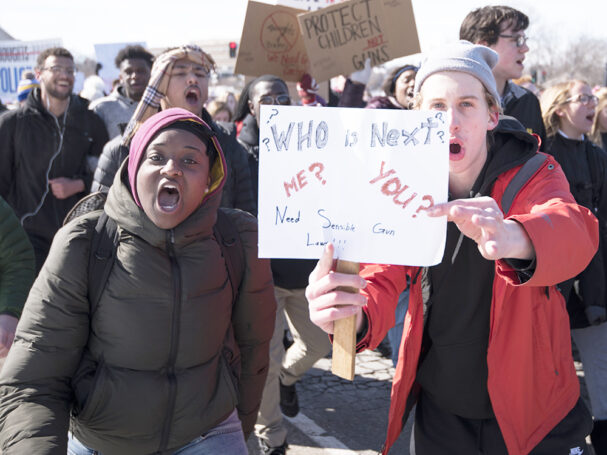
Sadly, the potential for being gunned down at school is also new with the increase in mass shootings. As a result, anti-gun violence movements have arisen among high school aged youth. Student debt is still another arena where capitalism singles out the young generation, with many now graduating college under the weight of crushing loans. Due to skyrocketing rents, many are unable to live on their own.
Voting rights is yet another issue as young voters are targeted in voter suppression efforts. Young people are also frequently looked down on or subjected to intimidation tactics.
Children and teenagers are the focus of ad campaigns for unhealthy foods and drugs as corporations vie with one another in pursuit of maximum profits. And last, but hardly least, reproductive rights must be highlighted as a cross-class issue confronting young women, trans men and others from several angles.
That special questions are cross-class issues does not mean they are not working-class issues. First, in any social group, there are large working-class majorities, and the issues affecting any specific community affect workers within them most sharply. The unique problems experienced by various groups of people also affect the ability of the working class as a whole to struggle in unity. Here, corporate imposition of lower wages for new hires is a case in point.
Inflation also places a heavier burden on those entering adulthood now, in comparison with previous generations.
Let’s examine more closely the social circumstances facing young people.
Young people today
According to the Pew Research Center study, What We Know About Gen Z So Far, people born after 1996 are “the leading edge of the country’s changing racial and ethnic makeup. A bare majority (52%) are non-Hispanic white … this generation is projected to become majority nonwhite by 2026.”

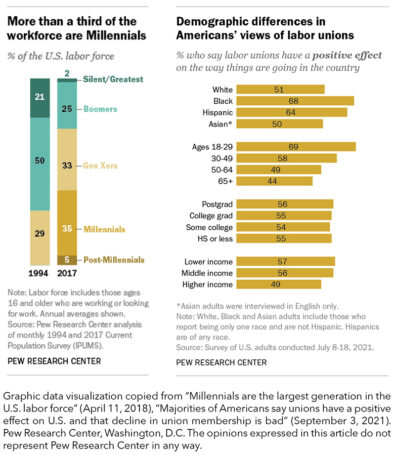 The increasing proportion of young people in the U.S. who are Latino is the greatest contributing factor. In the Western and Southern U.S., Gen Z is already majority nonwhite.
The increasing proportion of young people in the U.S. who are Latino is the greatest contributing factor. In the Western and Southern U.S., Gen Z is already majority nonwhite.
This provides important context to the current assault on immigrants and young people’s role in the fight against fascism.
Millennials also became the largest generation in the labor force in 2016, and a majority of them say labor unions have a positive effect on the direction of the country. Gen Z is one of the most, if not the most, pro-union demographic in the country.
Young people under capitalism
Youth aged 16–24 years are 11.7% of the population, but 20% of hourly paid workers, 48% of minimum and subminimum wage workers, and 27.7% of unemployed workers. Unemployment among young Black workers is more than 4 times the rate for 25 and ups overall.
Only 4.2% of young workers are union members, and young people work 7 jobs in their first 10 working years. Young workers are concentrated in industries that shed the most jobs during the pandemic, and were least able to work from home. Young workers are up to 2.3 times more likely to get injured at work, while 352 were killed on the job in 2020. The risk of death for young farmworkers is three times that of private-sector workers nationally, and child labor laws infamously do not protect those who grow and harvest our food.
Young people made up 23.4% of all arrests in 2020. Of the 10.6 million jail admissions per year, 18- to 24-year-olds make up 18% of those taken to the cells, and police use of force is a leading cause of death for young men: one out of 1,000 for young Black men. Schools with harsher disciplinary standards help funnel kids into jail: 2,600 5- to 9-year-olds were arrested in school from 2000 to 2019. Of 48,000 minors locked up on any given day in 2019, 42% of boys and 35% of girls were Black.
People living near highways (nearly 60 million), oil and gas facilities (17.3 million—including 3.2 million students and 12,400 schools and daycares), high-risk chemical facilities (124 million people), and landfills and toxic waste sites face elevated risks of cancer and various respiratory, cardiovascular, reproductive, and developmental problems. Poor people and people of color are especially concentrated in these areas. The death rate for Black children with asthma is ten times that of white children. Over 20 million U.S. people lack reliable access to clean water.
Meanwhile, healthcare is out of reach for many, especially for young adults. 16.5% of 18–29-year-olds are uninsured. (No wonder 69% of young people support government-run healthcare.) Only 47% of workers get health care from their job, and only 22% of those in service occupations, where young people are concentrated. Among the lowest-paid workers, only 35% get paid sick days; only 7% have paid family leave. Meanwhile, of the more than 187,000 lives lost to the opioid epidemic between 2014 and 2020, 17,200 were 15–24 years old.
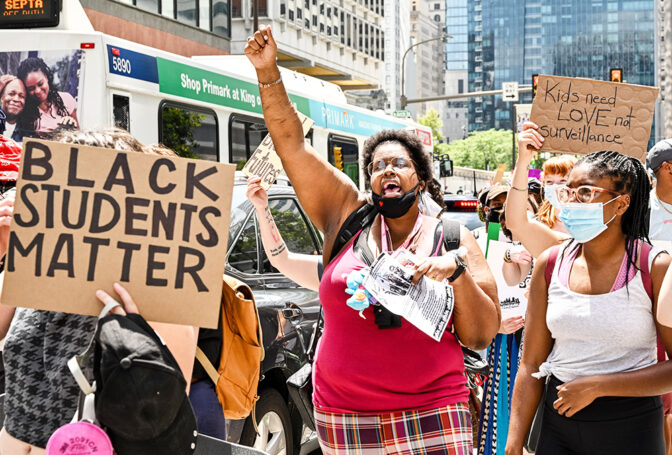 Underfunded public schools are being deprived of an estimated $150 billion. Average class sizes are far larger than they should be. And as pointed to above, schools are no longer safe havens: there have been 124 school shootings since 2018.
Underfunded public schools are being deprived of an estimated $150 billion. Average class sizes are far larger than they should be. And as pointed to above, schools are no longer safe havens: there have been 124 school shootings since 2018.
College tuition has increased 50% in the past two decades, costing more than $116,000 over 4 years. College debt now stands at over $1.7 trillion. Some 58% of the debt is held by women, and it takes them two years longer to pay it off while making higher payments. Public university students borrow $32,880 on average. Black college graduates owe an average of $25,000 more than white graduates.
All the above circumstances pave the way for military recruiters to target schools in poorer and minority neighborhoods, offering sign-up bonuses, free college and healthcare, expedited citizenship, and rosy images of military life. Ever since George W. Bush signed No Child Left Behind, public high schools have been required to provide the Department of Defense with students’ information, unless parents opt them out. Sexual violence in the military is rampant.
The class and social circumstances frame the ideological milieu shaping the thought patterns of tens of millions.
Ideological trends
Despite serious and escalating problems, a CIRCLE / Tufts University poll from 2020 revealed optimistic trends in young people’s thinking today. Eighty-three percent believe they have the power to change the country, and 60% feel they are part of a movement that will vote to push forward their issues.
Young people are also becoming more activist-minded: 27% of 18–24-year-olds attended a march or demonstration in 2020, up from just 5% in 2016.
Some 52% view socialism positively, while 54% have a negative view of capitalism. A majority of Democrats under age 30 reject U.S. exceptionalism.
Around three-quarters believe government has total or near total responsibility to prevent discrimination, to make sure people have adequate healthcare, and to protect the environment.
These are the key issues for young people, according to the pre-election poll.
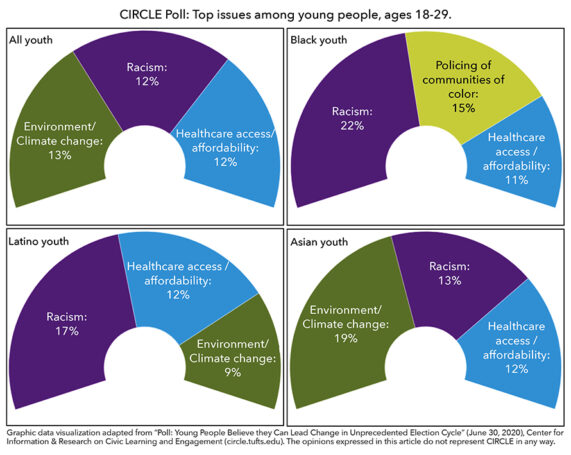
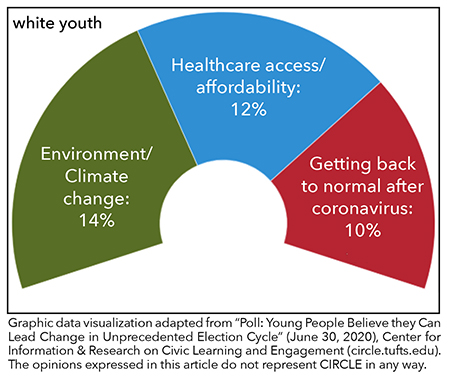 Black 18–29-year-olds put racism and police violence as the biggest issues on their minds, followed by access to healthcare. Latino youth also indicated racism and healthcare were their top issues, followed by the environmental crisis. Asian youth also listed these as their number one concerns, but saw climate change as the priority.
Black 18–29-year-olds put racism and police violence as the biggest issues on their minds, followed by access to healthcare. Latino youth also indicated racism and healthcare were their top issues, followed by the environmental crisis. Asian youth also listed these as their number one concerns, but saw climate change as the priority.
White people in the same age category, however, listed the environmental issue, healthcare, and “getting back to normal” after the pandemic as the most pressing problems. Racism didn’t register among their top three issues, though the poll was taken just one month after George Floyd’s murder.
New developments and upsurges
Also key to building a united youth movement, and earning a leading role in it, is understanding qualitative shifts and upsurges taking place in society, and the impact this new context is having and will have on young people.
Many Millennials were coming of age when Barack Obama was elected as the country’s first Black president, in the midst of the Great Recession. Many Gen Zers were voting for the first time when Bernie Sanders ran for president as a self-described socialist.
Tying these two events together were major upsurges, reactionary and progressive.
President Obama’s election was followed by the racist Tea Party reaction that gridlocked Congress in 2010 and led to Trump and the MAGA Republicans.
On the other side was the Occupy Wall Street Movement and then the Fight for 15 and a Union movement, as well as the first wave of Black Lives Matter demonstrations in 2013, responding to the murder of Trayvon Martin and the exoneration of the cop who killed him. Largely led by young people, these movements brought class and democratic issues into the national spotlight, even forcing the big business news networks to address them.
As a result of these movements, Bernie Sanders’ 2016 campaign was able to gain traction. Socialism, which had only entered the 2008 election as a red-baiting slur against Obama, was now openly embraced and promoted by a competitive presidential candidate. Many young people were radicalized when they saw the Democratic National Committee overtly tipping the scales against a popular progressive figure seriously addressing their issues.
Then came Trump, followed by the Women’s March, the largest single-day protest recorded in U.S. history. It’s been estimated that 1–2% of the population was on the streets that day. Shortly afterward, March for Our Lives responded to the high school shooting in Parkland, Florida, by demanding gun control.
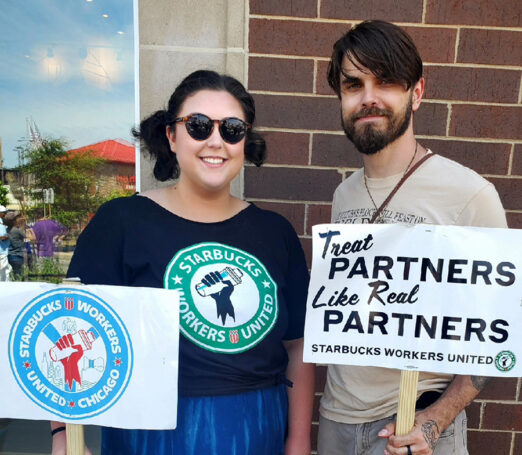 Today, the attempted coup on January 6th and the reversal of Roe v. Wade have created new circumstances. At the same time, Starbucks and Amazon workers represent a new phenomenon—young, militant, left-wing workers are taking ownership of the labor movement and leading ambitious organizing drives.
Today, the attempted coup on January 6th and the reversal of Roe v. Wade have created new circumstances. At the same time, Starbucks and Amazon workers represent a new phenomenon—young, militant, left-wing workers are taking ownership of the labor movement and leading ambitious organizing drives.
As Gen Zers are slated in the next few years to become majority non-white, another big shift is in the making—the U.S. is likely in the coming years to become a no. 2 economy.
Confronting these issues requires a mass, cross-class movement of young people, led by working-class youth, and allied with the working class as a whole, in all of its diversity. The issue is how do you build it?
Young people at the cutting edge
Young people also have a special relationship to the process of change. Today’s younger generation is developing in the context of a deep crisis in the capitalist system. These years are marked by tremendous upsurges. In many cases—whether it be Black Lives Matter, the fight for abortion rights, March for Our Lives, efforts to organize retail, service and logistics sectors (including Starbucks and Amazon), or the Virgina walkouts protesting the policing of gender in schools—it is young people leading these movements.
Still more, there are changes in technological, social, and political development, and in the rate at which they change. Mass movements have their ups and downs, and different issues come into the forefront at different times. There are changes in the nature of the right-wing reaction, changes in the broad left, and changes in mass consciousness.
In the midst of all this, new generations of young people are developing into young adults, undergoing physical, chemical, emotional and social changes, changes within their own social position within the economy, and are transitioning from dependency to independence.
Simultaneously, young people are developing their own ideas about the world around them. This is a collective process; young people are also developing socially. The conclusions they draw often stick with them for the rest of their lives, even as new generations emerge after them under new conditions.
“Those who are being socially ‘born’ and are just coming to social consciousness reflect current times in a sharper way than do older people.”
“This is a decisive time for the development of a revolutionary consciousness, a working-class outlook—or a reactionary, racist and bourgeois outlook, imperialism’s point of view,” Jarvis Tyner wrote in his 1977 article “Youth and the Working Class.” “Those who are being socially ‘born’ and are just coming to social consciousness reflect current times in a sharper way than do older people.”
In this regard, social media, facilitating the rapid spread of news, ideas, and culture, has become a new field of fierce ideological struggle. Our ability to influence in what direction young people move will have a profound impact on what direction our entire society moves in the coming decades.
At the same time, our attention to young people’s issues will help us become more attuned to emerging trends, and should allow the revolutionary working-class movement to get ahead of the curve in addressing the major issues of our time.
In order to harness all this potential for change, young people need to have the tools to organize their spontaneously emerging movements.
The Young Communist League
“Youth must of necessity advance to socialism in a different way, by other paths, in other forms, in other circumstances than their [parents],” Lenin wrote in 1916, arguing that without an independent youth league, the upcoming generation would be “unable either to train good socialists from their midst or prepare themselves to lead socialism forward.”
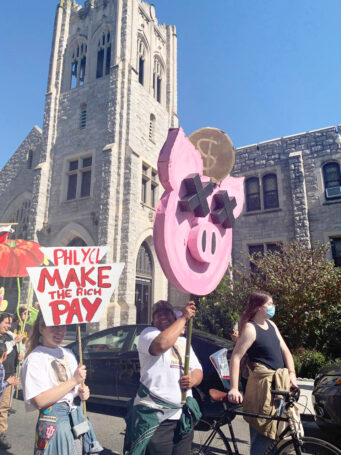 Some old approaches cannot be applied to new conditions. Ideas and rights that earlier generations had to fight for become part of the air that later generations breathe, and each generation has its own culture. It will be up to today’s young Communists to inject a Communist current into today’s youth movement.
Some old approaches cannot be applied to new conditions. Ideas and rights that earlier generations had to fight for become part of the air that later generations breathe, and each generation has its own culture. It will be up to today’s young Communists to inject a Communist current into today’s youth movement.
Since CPUSA’s 2019 resolution to re-establish a national Communist youth organization, significant progress has been made in this direction. A national party-YCL collective has been meeting, and YCL collectives have been established in many places around the country.
In addition to its fresh outlook, there are other vital strengths within the youth movement, including its tremendous energy. But it also has weaknesses, which underscore the importance of a close YCL-Communist Party working relationship.
There can be tendencies to look for quick solutions, leading to adventurist approaches. Some in the youth movement, of which the YCL is a part, underestimate the usefulness of their elders. Others have no knowledge of yesterday’s battles, won and lost. This can contribute to the repetition of avoidable mistakes, or the conclusion that “nothing ever changes,” fueling hopelessness or desperate actions.
Growing distrust of institutions under capitalism makes some hesitant to join any organizations, which are necessary for collective action. The chaotic proliferation of online information, conflict-driven discourse, and social media bubbles also undermines scientific thinking and healthy exchanges, mimicking middle-class moralizing, or pulling many into right-wing orbits.
“If these are insecure times, then the younger generation will reflect that insecurity most sharply,” Jarvis pointed out in the ‘70s.
However, even this should be flexibly conceived. For one thing, owing to young people’s unique circumstances, it will always be hard for the YCL to realize complete financial independence.
Additionally, the party and YCL are in a unique period. The YCL is still at an early stage in its re-formation. The party remains in a rebuilding process. There are large generation gaps within it, and there is a need for intergenerational leadership, and to continue building on the party’s accumulated experience. Considerable overlap is needed, therefore, between the work of the party and of the YCL. The YCL should not be seen as a way to segregate young people from the party, but as an additional space for young people to experiment and—most importantly—to build a united youth movement.
The YCL and the fight for unity
Gus Hall, in his address to the Young Workers Liberation League (YWLL) in 1982, warned against tendencies to imitate the Communist Party’s organization and style.
The YCL is both a youth organization and a youth movement, broader than the Party. It must reject concepts that will “narrow down its work” or “push it into sectarian corners,” Gus argued. To have a mass character, it needs a rich cultural and social life—a festive atmosphere, full of music, poetry, art, sports, and recreation.
“Who are you going to sign up as members?” Gus rhetorically asked. “Basically, non-Communists,” he answered. “You are not going to find young people who are ideologically pure or politically mature.”
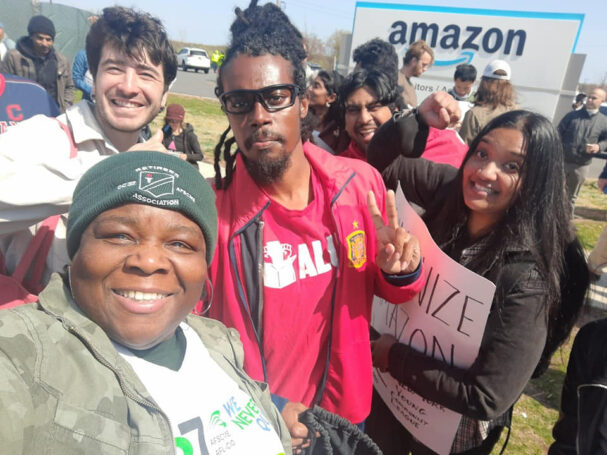 At the same time, the YCL needs to be politically and ideologically advanced and action oriented, strongly anti-imperialist, anti-racist, anti-monopoly, and “rooted in the concept of the united front,” said Gus. This means it needs to “master the art of education that is popular.”
At the same time, the YCL needs to be politically and ideologically advanced and action oriented, strongly anti-imperialist, anti-racist, anti-monopoly, and “rooted in the concept of the united front,” said Gus. This means it needs to “master the art of education that is popular.”
“All the work must move in the direction of developing class consciousness among young people … and socialist consciousness, too,” Hall advised.
The main job of the YCL is to build a mass united youth movement. It needs to find the main points of unity within the youth movement, and between it and other democratic and working-class struggles.
Another key role of the YCL is bringing to the forefront of the youth movement its working-class content, and building connections between the youth movement and the labor movement.
 “That will be one of your main tasks and challenges—how the new youth organization will relate to the class struggle and working class. How will you learn from workers?” Gus Hall challenged.
“That will be one of your main tasks and challenges—how the new youth organization will relate to the class struggle and working class. How will you learn from workers?” Gus Hall challenged.
As an anti-imperialist youth organization, the YCL is also a link between U.S. youth and the world’s youth—vital to the struggle for peace.
In order to build this unity, the YCL will need to identify key obstacles to that unity, and ways to overcome them.
Comrades at the 2022 Little Red Schoolhouse identified some of these obstacles, including lack of hope in the possibility of meaningful change, overemphasis on and disagreements about various organizational models, or right-to-work laws. Lack of organization among students in the U.S. might be another.
Study and struggle
In Tasks of the Youth Leagues, Lenin wrote: “The tasks of the youth in general, and of the Young Communist Leagues … might be summed up in a single word: learn.” But “what to learn, and how to learn?” he asked. “The upbringing, training and education of the new generations … cannot be conducted on the old lines. … [it] must proceed from the material that has been left to us by the old society.”
Lenin argued that the youth leagues should “learn communism,” but that this does not mean “assimilating the sum of knowledge that is contained in communist manuals, pamphlets and books”; otherwise, “we might all too easily obtain communist text-jugglers or braggarts” who “would prove incapable of combining the various branches of knowledge. … Without work and without struggle, book knowledge of communism … is absolutely worthless.”
In other words, the YCL must study and struggle.
And we should study not only communism, he wrote, but our own society, our own generation, and everything human society has produced up to the current time, examine it critically, and take only what is useful for us.
“Marx realized the inevitability of capitalism developing toward communism … on the sole basis of a most precise, detailed and profound study of this capitalist society, by fully assimilating all the earlier science had produced,” Lenin pointed out.
“Only a precise knowledge and transformation of the culture created by the entire development of [hu]mankind will enable us to create a proletarian [working class] culture. … You can become a Communist only when you enrich your mind with a knowledge of all the treasures created by [hu]mankind. … You should not merely assimilate this knowledge, but assimilate it critically, so as not to cram your mind with useless lumber.”
A central focus
In the struggle for unity, the YCL must develop a central focus and common demands which reflect the most immediate needs and interests of the great masses of young people.
The YWLL slogan later borrowed when the YCL was refounded was “Youth must fight for the right to earn, learn and live.”
Today we need to consider specific programmatic demands around which to fight, e.g., the right to education and day care, for racial equality, peace and an end to militarization and repression, and for expanded political rights. What would a youth bill of rights consist of in 2022?
As the YCL develops into a national organization, it will need to consider how it can apply these principles to today.
The opinions of the author do not necessarily reflect the positions of the CPUSA.
Images: United Students Against Sweatshops (Facebook); March For Our Lives student protest, photo by Fibonacci Blue (CC BY 2.0); infographic from On the Cusp of Adulthood and Facing an Uncertain Future: What We Know About Gen Z So Far (Pew Research Center); infographics from Millennials are the largest generation in the U.S. labor force and Majorities of Americans say unions have a positive effect on U.S. and that decline in union membership is bad (Pew Research Center); “Black students matter” photo by joepiette2 (CC BY-NC-SA 2.0); adapted infographics from “Poll: Young People Believe they Can Lead Change in Unprecedented Election Cycle” by CIRCLE; adpapted infographic from “Poll: Young People Believe they Can Lead Change in Unprecedented Election Cycle” by CIRCLE; Chicago YCL (Twitter); Philly YCL; NY YCL (Facebook); DC YCL (Twitter);


 Join Now
Join Now